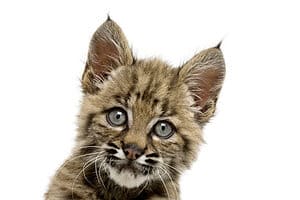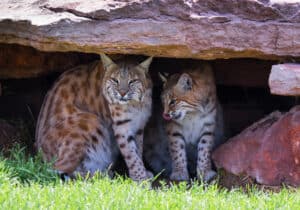Bobcats are a distinctive kind of wild cat that lives in North America. As large as a coyote, equipped with sharp teeth and claws, and the ability to jump 12 feet in the air, they’re not to be taken lightly, no matter how cute they might look with their spotted coats and tufted ears. Nevertheless, in many parts of the country, it is legal to keep them as pets. And in the wild, their numbers in the wild are on the rise across the country. What about Alabama? How many bobcats live in Alabama, and are they dangerous?
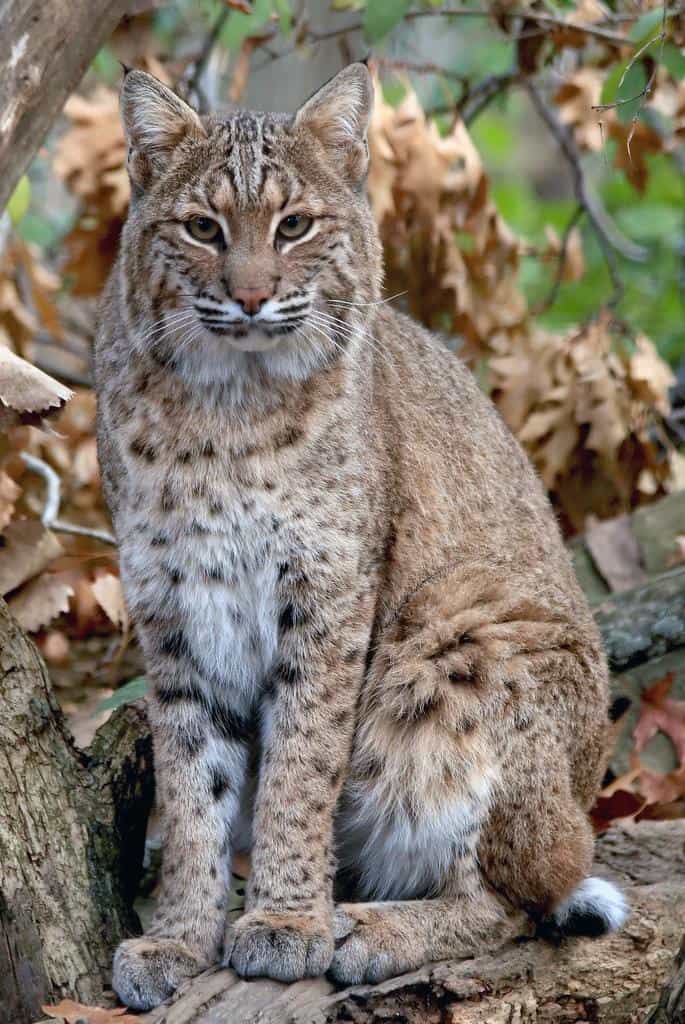
The beautiful spotted color of the bobcat’s fur helps camouflage it in a variety of habitats and seasons of the year.
©Becker1999 (Paul and Cathy), CC BY 2.0, via Wikimedia Commons – License
What to Know About Bobcats
What Do They Look Like?
Bobcats are big wild cats that are native to North America. People sometimes call them “wildcat” or “lynx.” A grown male bobcat is huge when you put it side-by-side with a regular housecat. It can grow to 40 pounds and be 37 inches long, whereas a housecat may reach just 12 pounds and 28 inches long, on average. And in the case of the housecat, that length includes a long skinny tail, while the bobcat is born with a short tail that looks “bobbed.” In size, a bobcat is really closer to a medium-sized dog or coyote than a cat.
Bobcats have fur of brown and white with some darker streaks and spots. Their bellies are mainly white. Something that makes their appearance distinctive is the hair on their cheeks that stands out in a ruff and on each ear, where it tufts up in a point. It’s easy to see how the bobcats have survived and multiplied for over a million years. They have developed strongly muscled bodies armed with razor-sharp teeth and claws and are guided by outstanding senses of sight, hearing, and smell. These are solidly packed, formidable little carnivores that can make other animals or people much larger than themselves wish they had not crossed paths with them!
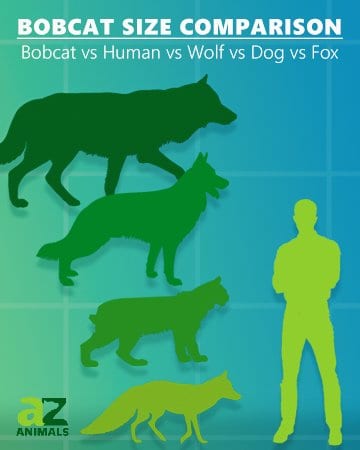
Where Do They Live?
Bobcats adapt themselves to all sorts of different climates and natural biomes. You can find them in the deep evergreen forests of Canada, the deserts of Arizona and Mexico, or the swamps of Florida or Louisiana. They prefer to keep to themselves. Males claim a territory of up to 30 square miles that overlaps the territories of females, who claim just 5 square miles or so. This allows the females to stay closer to home to take care of the young, while the male is able to range farther and mate with multiple females. They mark their territory with urine, feces, oil from scent glands, and scratches on trees and rocks, as well as using a lot of different loud vocalizations to let other bobcats know they’re around.
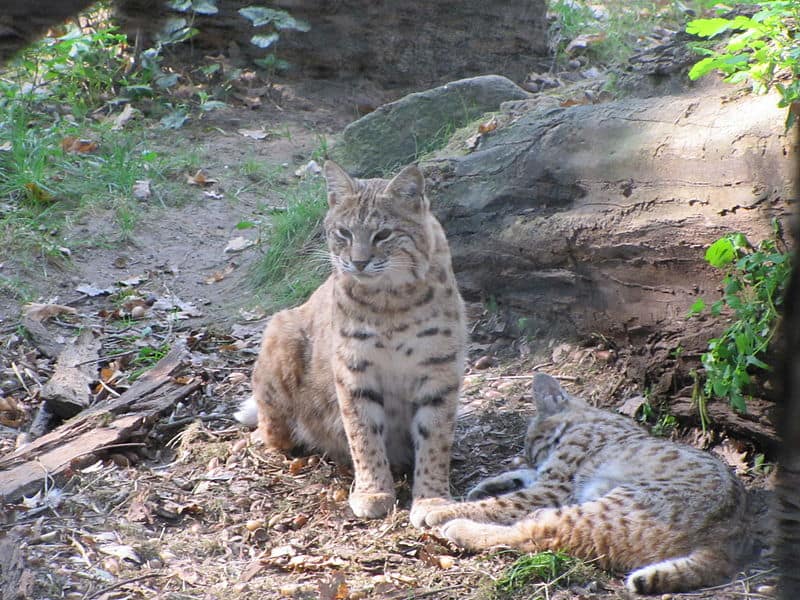
Bobcats are usually solitary creatures. These two are still young but will leave to establish their own territories.
©Redrobsche, CC BY-SA 3.0, via Wikimedia Commons – License
Where do Bobkittens Come From?
Winter is the usual mating season for bobcats, though it may start as early as November and actually continue through the spring and summer at times. It takes about 62 days after conception for young to be born. The mother will choose a secure den in a hollow tree, a space between big boulders, a cave, or in a dense patch of shrubbery. She will line it with moss and leaves to keep it warm and soft.
Her young are called “bobkittens” or just “kittens.” The mother does not let the male near them, but he will continue to roam through the outskirts of the territory to keep an eye on things. After nursing for two months and spending another three to five months learning to hunt, the bobkittens will go off on their own. They are usually gone in time for the winter mating season, when the cycle will start again. Females are ready to bear their own bobkittens after a year, and males are ready to mate after age two.

Bobkittens stay with their mother a few months, but are quickly ready to live life independently.
©Ultrashock/Shutterstock.com
What Do They Eat?
Bobcats like to eat small rodents like rats, mice, rabbits, and squirrels. Sometimes they will take down a deer that is elderly, injured or sick, or a young fawn. Without them, the population of small herbivores would explode. Vermin like rats and mice would spread disease and damage crops. Rabbits and other herbivores would eat down vegetation, and this could contribute to soil erosion. If bobcats were removed from the environment through overhunting, for example, then other predators like coyotes, mountain lions, and rattlesnakes would proliferate. For most people, those species would be even more frightening than the shy bobcat.
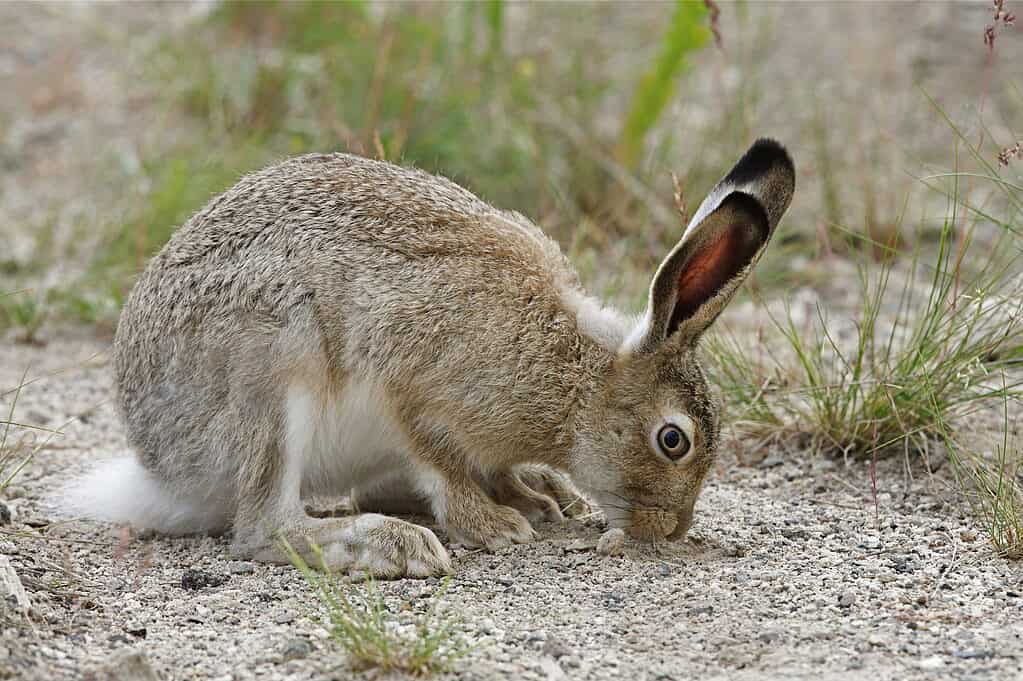
The population of rodents would multiply dramatically if the numbers of bobcats in the wild were reduced.
©Tom Reichner/Shutterstock.com
Are Bobcats Endangered?
With anywhere from 1-3.5 million bobcats roaming North America, this is a species that is not at all endangered. The International Union for Conservation of Nature (IUCN) classifies them as a species of “least concern.” The population of bobcats has been increasing greatly, especially since the 1990s. Their natural predators include wolves, mountain lions, coyotes, foxes, predatory birds like owls and eagles, and of course, humans. The two main ways humans threaten bobcats today are from hunting and removing their habitat through land development.
In Alabama, hunters can hunt bobcats, coyotes, feral swine, and foxes all year round with no bag limit during the daylight hours. It’s require to have bobcats tagged within 14 days by a representative of the Wildlife and Freshwater Fisheries Division. Why do people hunt bobcats? A bobcat pelt can be worth up to $300 or so in the fur trade. Other people might not want them around their property where they could prey on livestock or injure pets or children. Sometimes it’s just the love of a good hunt, the thrill of learning about the habits of a different kind of animal, tracking it, and successfully overcoming it to bring back a story and a trophy.
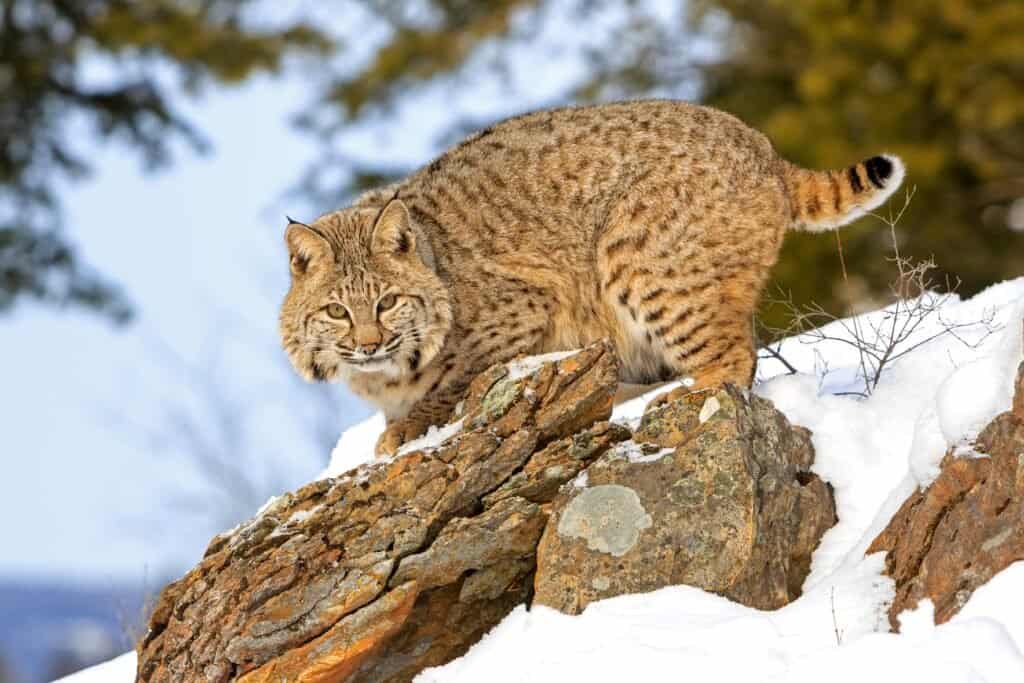
Bobcats can be hunted all year long in unlimited numbers during daylight hours in Alabama.
©Jack Bell Photography/Shutterstock.com
Where You Might See a Bobcat in Alabama
Bobcats shy away from people as long as they can find enough to feed themselves in the wild. Alabama has plenty of forested land, swamps, hills, and rural areas to keep them well-fed and well-hidden. As cities expand and more land comes under development, however, they are beginning to show up on urban and suburban fringes, as are coyotes, foxes, and other wild creatures not normally seen in cities. This has led to increasing reports across the country of people occasionally spotting one or encountering them on a trail or on their property. A housecat or small dog can be prey for a bobcat, especially if they are having difficulty finding prey in the wild and are choosing to venture closer to humans, or is the domestic animal is roaming through the woods where the bobcat has its territory.
If you suspect bobcats might be in the area, keep a lookout for their tracks in mud or snow, with four toes and a metacarpal pad shaped like an “m.” They are most active around dusk and dawn. The best way to keep them away from your property is not to let your pets out unsupervised at those times and don’t leave pet food, meat scraps, or bones out.
With a vertical leap of 12 feet, they can easily get over any kind of fence, and can climb trees and drop down from limbs if they can’t get over the fence itself. But a fence will be useful to keep your animals in, so they don’t roam out into dangerous territory. Other ways you can prevent them from roaming around your land are to leave a radio playing outdoors in the morning and evening with the sound of people talking, removing hiding places on the property like rock piles or wood piles or areas of overgrown vegetation, keeping grass cut short, and installing motion-activated lights or sprinklers.

Bobcat tracks are a tell-tale sign one has paid a visit to your property.
©Bobcat tracks in the mud/Shutterstock.com
Protecting Yourself from a Bobcat
It’s very rare for a bobcat to attack someone unprovoked. However, they might be more aggressive if they are sick, hurt, or defending territory because it’s mating season or they have bobkittens nearby. So, let’s say you go out for a walk one evening and turn a corner and find yourself face to face with a bobcat. It looks just as startled as you do. You both freeze. Now what?
- Back away slowly. Do not turn and run because it will trigger the bobcat to chase you like prey.
- Put as much distance as you can between yourself and the bobcat.
- Make loud, scary noises to frighten it off. Yell, scream, bang camping pans together.
- Throw things at the animal: rocks, sticks, a book, a box of fishing tackle, anything you can find.
If the animal is attacking your pet, get yourself a safe distance, make noise and throw things. If you are in your yard, turn on a water hose and spray the animals. Do not intervene physically with your body to pull your animal out of any kind of fight, but especially not the kind of knifefight a bobcat brings. Imagine what a housecat would do to you and multiply that by a hundred. You’re not going to win, and quite honestly, you might not even survive.
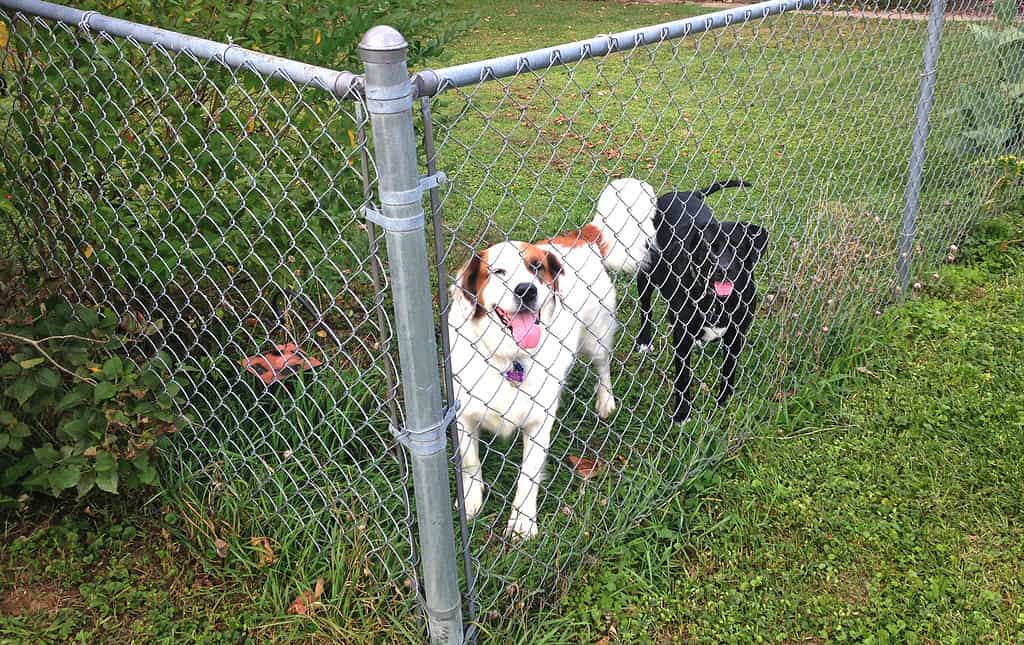
Fencing won’t keep out bobcats, but it will keep Hemi and Bitsy from trailing one into the woods and getting a smackdown.
©Wendy van Overstreet/Shutterstock.com
Bobcat Hybrids?
Maybe this isn’t so much an urban legend as a rural legend. The story will go around that someone’s brother’s cousin’s best friend’s nephew had a cat that had kittens and they grew bigger than the dog and turned out to be bobcat hybrids. Can it really happen? The answer is “no.” There’s a large size difference and the animals have differences in their reproductive systems.
This is a good time to remind all of us to have our animals spayed and neutered, and then we don’t have to worry about any weird hybrids or kittens of any other kinds, either. There are over 70 million wild and feral housecats in the United States and they are a really destructive invasive species. Smaller and more lithe than bobcats, they can get into smaller spaces and up into trees where they pray on bird species. They overlap more with human habitats, with some that were once in captivity going back to people’s houses to get fed and then rejoining feral colonies. This makes them much more problematic for the spread of disease to domestic animals and people.

Stray cats are a bigger problem than bobcats, because they move freely and transmit diseases.
©Katamount/Shutterstock.com
Can You Keep a Bobcat as a Pet?
So, can you own a bobcat as a pet in Alabama? As of 2023, the answer to that question is “yes.” Alabama is one of five states that permit bobcat ownership without a permit. You can check out the status of every state’s law on bobcat pet ownership at this site. 95% of Alabama is rural and has no limits on the number of pets you can own. So, you could also adopt as many of those 70 million feral housecats as you want. But would you really want to do either of those things?
Even if born in captivity, bobcats still have wild instincts and will be difficult to train and control. Some owners might choose to de-claw them, which will deprive them of their climbing ability and the ability to hunt and defend themselves if they ever escape captivity or are released into the wild again. Think too of the ways they mark their territory and consider whether you’d want the urine and feces of a large cat marking the boundaries of your house and yard. Even if you can own a bobcat, that doesn’t mean you should own a bobcat.
But would you consider a pixie-bob? It is 100% housecat but bred to look like a little version of a bobcat, right down to the ear tufts and face ruff, thick body, and bobbed tail – which they are born with, by the way, not cropped. It’s a great alternative if you’d like all that bobcat cuteness without those pesky ambulance rides to the hospital every time you try to play with it. And what makes it even better than a bobcat is all the fun you’ll have convincing your friends that housecat-bobcat hybrids are real!
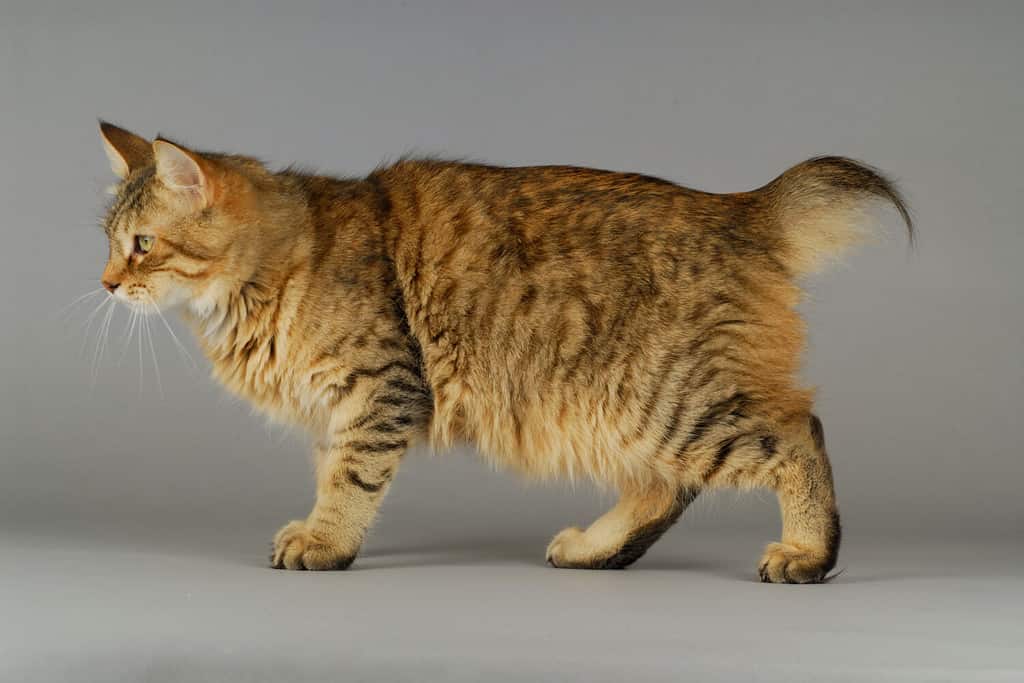
This is a pixie-bob, specially bred to look like a bobcat, short tail and all.
©COULANGES/Shutterstock.com
The photo featured at the top of this post is ©
Thank you for reading! Have some feedback for us? Contact the AZ Animals editorial team.



